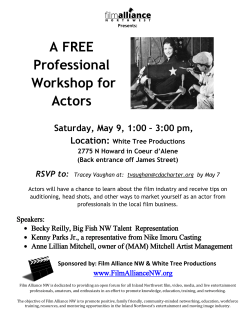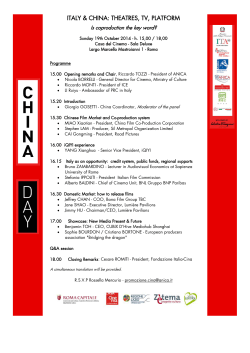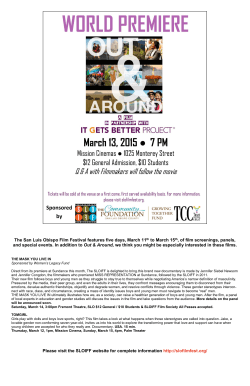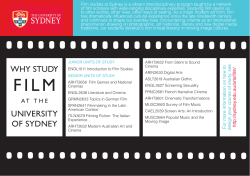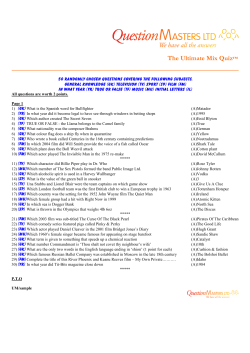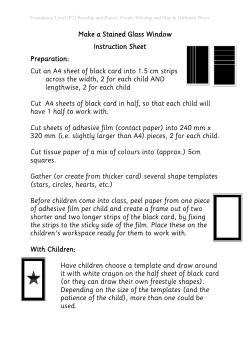
Screening Programme (updated 26/03/2015)
World Cinema and the Essay Film: Screening Programme (updated 26/03/2015) Thursday, 30 April 2015 17:15 – 12:00: Walter Salles Jia Zhang-ke by Walter Salles (2015) The screening of the film will be followed by a Q&A session with Walter Salles and Prof Lúcia Nagib (note that both events are in planning, but still need to be confirmed). Friday, 1 May 2015 11:15–12:15: Meditations on Time 18 (+2) Blinks of an Eye (2002) by Anuradha Chandra (23 min.) The images and sounds reflect the experiences of the filmmaker while living in Chicago. The film is a wordless meditation on the nature of ‘time’, an everyday phenomenon on one hand, and an elusive but pervasive, philosophical and scientific concept on the other. The film explores ‘time’ through a variety of moments: some whir past, some linger and some seem painfully long. A train arrives, a drop of water begins to fall, a juggler throws a ball, an eye blinks. The film moves away from the clinical measurement of time, to an experiential, bodily understanding of it. Pulse (2008, 2013) by Anuradha Chandra (23 min.) Shot without a lens, this film is a portrait of time, recorded through a pin-hole in Rotterdam (Netherlands). In the first half of the film, the absence of words allows viewers to reflect on a series of images: throbbing, pulsating with a day's beginning and its ceaseless state of flux. In the second half, the film shows the same images and a voiceover begins telling stories; of a man's memory of a day in his childhood, an image resonates with the stories of a village and another telling begins. The images of the now take on the dust of the past and a silence of an intuited future. (Lunch Break) 14:30–16:45: Essay Films from Colombia 16 Memories (2008) by Camilo Botero Jaramillo (53 min.) Filmed between 1945-1971, 16 Memories tells the story of the Posada Saldarriaga's, a family from Medellín that grew up during the industrialization's euphoria. Twenty-five years of daily life almost uninterrupted, in a big and old house. They give us the strange possibility of seeing our infancy for the first time. Looking for the origins of the adult life and recognizing the distance that separates us from those wonderful scenes, turns to be the unique evidence to assure us that there was a time when we believed that every day were going to be hot, simple and blue. My Silver Camera (2015) by Camilo Martín-Flórez (5 min) My silver camera is a meta-audiovisual-essay that inquires the narrative possibilities that the new digital tools offer. This piece also reflects on the elements that composed an audiovisual: the sound and the image. Generally we refer to the audiovisual pieces as films, movies or videos, and all these labels are exclusive terms that imply more than what they express: i.e. cinema, film, movie or video imply sound but (contrary to its visual component) the aural component is never explicitly mentioned. My Silver Camera Is a audiovisual-essay that at the same time attempts to reflect on the concept of time and space." (15 minutes coffee break) The Strange Presages of Leon Prozak (2009) by Carlos Santa (63 min.) León Prozak lends his head to Mefistópheles for a series of circus acts. This film consists of kaleidscopic scenes, animations, made by different visual artists, whose work is based on the pleasure of painting time. These animated paintings take on several topics, from politics to eroticism, by expressing shocking visions on the world. Saturday, 1 May 2015 9:00-13:00: Of Places and People Edifício Master (2002) by Eduardo Coutinho (110 min.) For one week, Eduardo Coutinho and his team talked to 27 residents in an enormous building in Copacabana. Amongst these are a middle-aged couple who met through the classified ads in a newspaper, a call-girl who keeps her daughter and her sister, a retired actor, an ex-football player, and a janitor who suspects that his adopted father, whom he dreams about every night, is his real father. The subject of this documentary is private life in the big city, apartments as a last stronghold of individuality, in addition to emphasizing the fact that to live together in one and the same place does not ensure that a community will be formed (the screening will be followed by a Q&A session with Consuelo Lins and Igor Krstic). (Coffee Break) Dekho, Purani Dilli (Seeing Double, 2015) by Karl Mendonca Dekho, Purani Dilli is an essayistic, experimental film that uses the aesthetics of ethnographic film practice to explore the entangled issues of representation and subjectivity of place. The film was made during a fellowship that I was awarded at the UnBox 2011 design conference in New Delhi and is composed of a series of encounters, where objects and people form part of a material network and a filmic context for the question ‘Is Old Delhi Modern?’ (Lunch Break) 14:15-15:30: (Self-) Portraits Of dice and men (2015) by Didem Pekün (28' min) Of dice and men is an essayistic video diary punctuated by significant moments — some of purely subjective consequence, while others became markers in shared history. The work presented includes footage of the Occupy movements that began in London in 2011 as well as Istanbul’s Gezi protests in 2013. Such major disturbances of daily existence are interlaced with more joyful and elusive experiences: boys diving into the Bosphorus, a first encounter with a feat of nature. Acutely aware of the political dynamics and pressures that surround her, Pekün captures moments of rupture in day-to-day life and highlights the nature of violent occurrences in both Istanbul and London. Closer Than They Appear (2015) by Kim Munro (approx. 20 min.) This film is an essayistic expedition through the secrets, foibles and dogged persistence of human relationships. Part fiction, mostly fact and generally true, each song-like chapter is a quest to get closer to the enigma of what it means to connect with another person; from a secret cold war bunker to a mysterious pen-pal in Fiji, from a town of a single inhabitant to a cat island in Japan, and from myths of everlasting love to the Museum of Broken Relationships. Tülay German: Years of Fire and Cinders (2010) by Didem Pekün & Barış Doğrusöz (50' min) Tülay German: Years and Fire and Cinders unravels the memory of a forgotten musical icon through the point of view of the director, highlighting the ties of the past with the present. The film simultaneously narrates German’s musical evolution whilst recounting the historical period in turmoil within which it took shape. Tülay German’s autobiographical book The Black Box of The Plane Which Never Crashed is taken as a basis and her music, photographs, archives are used to re-animate a lost history that takes place between Paris and Istanbul. (Coffee Break) 15:45- 16:15: Found Footage / Found Remnants Transgressions (2015) by Júlia Machado (15 min.) This essay film presents on screen some challenging taboo-breaking cinematic representations of the body, such as close-ups of genitalia, sexual penetration, animal slaughter as well as scenes of necrophilia, humiliation, disgust, and abjection. Selected from a variety of films representing a broad range of genres, film traditions and filmmakers, those images are woven together in a montage accompanied by a descriptive narration. In presenting this material, Transgressions discusses different ways in which taboos are broken Two Emperors and a Queen (2015) by Vesna Lukic (8’ min) This epistolary video essay brings forth the beginning of the correspondence between a cineaste, Stanoje Backo Aleksic and the former secretary of the Yugoslavian Jewish Community, Naftali Bata Gedalja. The video is part of a larger PhD practice-as-research project on the ‘Kladovo transport’: a large group of about 1200 Jewish refugees from central Europe whose unsuccessful escape attempt tragically and fatally ended on Serbian soil in 1941/42. The video shows the boat on which the Jewish emigrants lived during their Danube journey. It is today a shipwreck on the Danube shore in Kladovo. in art house cinema, avantgarde experimental cinema, horror films and pornographic film.
© Copyright 2025
